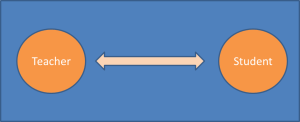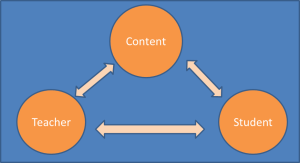06.24.16Competence and Trust, Part II–A Guest Post From Dan Cotton
This is the second of three posts by my colleague Dan Cotton that’s based on a series of conversations we’ve had about the nature of relationships in the classroom. The first post appears here.
Dan writes:
Consider this brief moment from outstanding high school English teacher Beth Verrilli’s classroom: Her students are reading Macbeth. They’re coming out of 5 minutes of independent work time, reading and annotating a speech by Lady Macbeth. Watch Beth’s facial expressions and body language as her students share their thinking:
Verrilli for Cotton Blog from Uncommon Schools on Vimeo.
A genuine smile blooms as the timer goes off – “Alright, alright, there are some good answers here…” She’s on the balls of her feet, crouching, pointing as the second student prepares to build on the first’s thoughts. When Ifigenia (Iffy) identifies the serpent as a biblical reference, Beth walks over, gives her a fist bump and a “Yessss.” It’s an authentic moment of relationship building, and instructive.
When Iffy unpacks the biblical allusion, it’s not Beth’s fist bump that strengthens their relationship, though I suspect Iffy appreciated it. It’s Iffy experiencing Beth’s genuine excitement at her achievement with the content that connects them. In other words, you could watch the video and conclude, “I should fist bump kids in my classroom to build relationships,” but unless you had helped your students achieve powerful insights that they felt like fist bumping you about, it wouldn’t help much.
In part 1 of this series, I posed two questions: what do we mean when we stress the importance of building strong relationships with students? And what kind of relationships are strongest? This small moment from Beth’s class offers some answers.
Often when educators consider student-teacher relationship building they focus on the ways in which a teacher signals his/her willingness to connect with students. You might picture it as a two-way circuit, like this:

When that is the model guiding teachers’ attempts to strengthen their relationship with students, it sometimes leads to ineffective attempts to connect via topics outside of the classroom or sharing of personal information–Did you see Curry’s first three pointer in the game last night? My dog makes the funniest noise when he wants to go outside. List five things you like to do when you’re not at school.
That may work with some students but only some are eager to have “friend-like” relationships with teachers. Others seek relationships of trust and appreciation focused on teaching and learning about something important together. Think of the most influential—in a personal sense—teachers you had. Maybe some of them were friendly outside the classrooms walls. But surely some connected with you because they built in you an abiding love of and interest in the topic of their class. And those relationships are no less valuable.
The danger then is an incomplete model of the context and dynamic of the classroom. A more accurate and useful model, and what we see in the clip from Beth’s classroom, is this:

Beth’s passion for the content and her genuine excitement when she sees Iffy achieve an important insight is the source that then connects teacher and student. These aren’t one way flows of energy. It’s a constant, multi-directional dynamic: The student-teacher relationship motivating the student to embrace the content, the student’s achievement with the content fueling the teacher’s connection to the content, the teacher’s passion for the content inspiring the student to embrace the content. What’s evident and important in the Beth clip is this lesson: Too often educators (particularly new teachers), think that a strong student-teacher relationship is a necessary pre-condition to a student’s academic achievement, when just as often, it’s a teacher authentic excitement about a student’s legitimate achievement with the content that creates and strengthens the student-teacher relationship.
I think about this too with one of the most important relationships in my life, with my 8 year old son. We’re currently working our way through Harry Potter (we’re in book 6). The ritual of bedtime reading – the cuddling, the shared experience, the primacy of voice and text—is a source of connection all parents relish and understand. But it’s also about content: Why can’t they just smash the Horcrux? (he’s asking) What’s going to happen next in the cave? (I’m wondering, because it’s late and we have to stop before we finish the chapter). The strength of our relationship grows because of our shared engagement with content.
Earlier I used the word “danger,” deliberately, to describe the risk of an incomplete model for thinking about student-teacher relationships. It’s a danger because not recognizing the critical role of content can lead teachers to attempt to build relationships with students by talking about their own lives or their students’ lives outside the classroom. (To be clear, I’m not saying those moments of sharing should never happen or aren’t important, just that they aren’t the only way). And, aren’t we subtly lowering expectations – for our students and ourselves – if we assume that we won’t connect with students around rigorous content?
Recognizing that content is central to relationship building is practical, sustainable, and, ultimately, more enduring. I may not be able to find the outside topic through which I can genuinely connect to each of my students. It may be off-putting to some students to hear from me about my personal life. Yet celebrating my excitement about their achievement with our content is an avenue of connection available to me with each of my students. Kahlil Gibran famously wrote on teaching: “If he is indeed wise he does not bid you enter the house of his wisdom, but rather leads you to the threshold of your own mind.” If a personal relationship emerges and endures, that’s wonderful. It’s one of the great gifts of teaching. Ultimately though, what we strive for, is for students to discover their own potential and greatness.
There are many fantastic teachers who form deep and enduring relationships with students and they never spend any time together outside of the classroom while the student is the teacher’s official responsibility. The richest opportunity for student-teacher relationship building is in the daily interactions of the classroom as students strive towards achievement with the content.
What’s true about our professional and personal relationships is true, too, of our relationships with students: Authenticity matters. As we saw in Beth’s clip, authentic celebrations of achievement need not be over the top. When we genuinely acknowledge and convey our enthusiasm for our students’ success with content, we project that most fundamental of human emotions: love.
